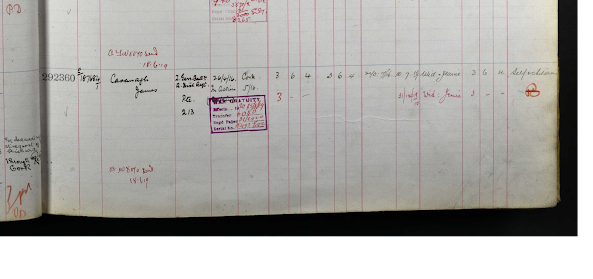Formed in Dublin in March 1916, there doesn't appear to be too much information regarding 2nd (Garrison) Battalion, Royal Irish Regiment. It appears to have been designated for Home Service.
The Long, Long Trail website indicates it remained in Dublin until April 1918 where it's name was changed and it went to France
https://www.longlongtrail.co.uk/army/regiments-and-corps/the-british-infantry-regiments-of-1914-1918/royal-irish-regiment/
Soldiers started joining the unit on the 11th March 1916 with a cadre of NCOs and soldiers, numbers being assigned with 2G/ as the prefix. Number 2G/1 went to CSM Arthur Marshall, a Londoner born on 29th April 1967, who joined from the Royal Irish Rifles. Most of the names listed below appear to have joined from the Royal Irih Rifles.
| No | Rank | Forename | Surname |
| 2G/1 | CSM | Arthur Woodriffe | Marshall |
| 2G/4 | RSM | Joseph | Sullivan |
| 2G/7 | CQMS | Robert | Gamble |
| 2G/8 | Sgt | Patrick Joseph | Houston |
| | | |
| 2G/16 | Cpl | Richard | Waide |
| 2G/17 | | William | Neill |
| 2G/18 | L/Sgt | John | Crossley |
| 2G/21 | A/Cpl | Charles | Graham |
| 2G/22 | L/Sgt | William Richard | Young |
| 2G/44 | Pte | Patrick | Carroll |
| 2G/47 | Pte | Robert | Doyle |
| 2G/51 | Pte | William | Davis |
| 2G/60 | Pte | Robert | Flaherty |
| 2G/73 | Pte | William | Hughes |
2G/7 CQMS Robert Gamble was a Dubliner. Killed during the Easter Rising near Beggar's Bush Barracks on the railway line.
We can assume that most of the above were in Dublin at the time of the Rising, though the Battalion is not listed in the various books that give details of the units present on 24th April.
Privates Waters and Flynn mentioned as injured/killed at the Magazine Fort do not appear to have been assigned 2G/ numbers.
Henry Agnew appeard to have joined the unit on the 15th April and assigned the number 2G/646.
It does raise the question of how many men of this unit were in Dublin at the time of the Rising, what were they doing on Day 1 and what did they do on subsequent days. Were there others like Flynn and Waters who did not have 2G/ numbers.
The unit Commanding Officer appears to have been Lt. Colonel Sir Frederick W. Shaw, D.S.O. who made his way to Beggar's Bush Barracks at the start of the Rising (he had been in command of the Ulster Volunteer Force aligned 2nd Bn, Loyal Dublin Volunteers in the run up to WW1).
2nd Lt Edward Gerrard, Royal Field Artillery, arrived in Beggar's Bush Barracks on the 24th April and noted that 2nd (Garrison) Bn, Royal Irish Regiment men were there :
one or two ranker officers (promoted from the ranks)
4 NCO's
10 men (including 3 invalids)
I had read somewhere about the unit possibly being at Richmond Barracks - possibly in conjunction with the research on Flynn and Waters or re the death of 2G/213 Pte James Cavanagh, from Co Monaghan, who looks to have been killed in the South Dublin Union area (another former Royal Irish Rifles soldier)
https://www.cwgc.org/find-records/find-war-dead/casualty-details/899910/james-cavanagh/
The UK Soldiers Died in the Great War has Cavanagh as died in Gallipoli. More likely he was wounded in Gallipoli and that was the reason for his transfer in Dublin.
Officers identified as being with the Battalion at some stage are :
| Rank | Forename | Surname |
| Captain | Thomas | Powell |
| Captain | Edward Francis Nathaniel | Burton |
| Lt | | Morgan |
| Captain | F R | Robinson
|
A few details of their service but nothing re role in the Rising yet.
The 2nd Garrison Battalion, Royal Irish Fusiliers was also formed in Dublin around April 1916. This appears to have not been for Home Service - moved to Templemore in May 1916 and then sent overseas.
Private Joseph Cullen from this unit appears to have been killed in Dublin on the 25th April 1916
https://www.cwgc.org/find-records/find-war-dead/casualty-details/899969/joseph-cullen/
He appears to have been a pre-war soldier and entered France on 8th October 1914 with 2nd Royal Irish Rifles, number 4550.

No comments:
Post a Comment